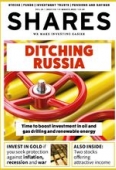Archived article
Please note that tax, investment, pension and ISA rules can change and the information and any views contained in this article may now be inaccurate.
This sell-off is unlike any other and so are the opportunities

In past periods of market stress, we have been able to look back at previous sell-offs and predict with reasonable accuracy which sectors were likely to perform best when sentiment recovered.
However, both major declines since the start of this decade have been very different to previous episodes which means history may not be much of a guide to what happens next.
Given the inflationary environment, we believe investors would be best served focusing on companies with the ability to raise prices thanks to high barriers to entry and low risk of product substitution.
HISTORIC PRECEDENT
Over the decade of ‘normal’ markets from 2010 to 2019 we had the comfort of knowing that when jitters occurred the sell-off was likely to be brief and certain sectors could be relied on to lead us out of the doldrums with index-beating returns.
The short, sharp declines which took place in 2011, 2016 and 2018 all triggered a drop of more than 10% in the FTSE 350 index.

All three sell-offs may have been unique in terms of their cause, but in all three cases most sectors followed a predictable path down and up again.
On average, the downturns wiped around 17% off the index while the average rebound was 19%, and to all intents and purposes the market returned to ‘as you were’ mode within a couple of months.
The best performing sectors across all three periods were, in descending order, beverages, software and computer services, pharmaceuticals, personal goods, and health care equipment and services.

Not only did these sectors fall less than the index, they rebounded by more.
The beverages sector was the stand-out performer, losing just 3.5% on average when the market fell and gaining 23.6% when stocks rallied.
ALL CHANGE
When markets sold off in February 2020, due to the acute impact of the Covid-19 pandemic on the hospitality industry, beverage stocks performed almost as badly as the index, dropping 31% against 34% for the benchmark.
As well as travel and leisure, energy stocks took a beating alongside life insurers and car makers.
Personal goods and pharmaceuticals were once again reasonable hiding places, while telecoms and utilities were the other outperformers.
What really caught investors out was that, far from getting back to ‘business as usual’ a few months later, the index only managed to recover 60% of its losses by early June 2020 before rolling over again.
Some sectors came close to recouping their losses, namely construction, general industrials, industrial metals and precious metals, but for the sectors that fell the most the rebound fell way short.


CURRENT STATE OF PLAY
Fast forward to today and after a 10% fall from 10 February to the low on 7 March the FTSE 350 seems to have stabilised.
Once again, though, the unique nature of the sell-off makes predicting which areas of the market will outperform from here a fool’s errand.
Some sectors have gone up since 10 February, such as aerospace and defence. Given the commitment by countries including Germany to increase their military spending, this makes complete sense.
 Other sectors to have posted gains are electricity, gas, water and multi-utilities, industrial metals and mining and pharmaceuticals.
Other sectors to have posted gains are electricity, gas, water and multi-utilities, industrial metals and mining and pharmaceuticals.
Among the familiar faces posting the heaviest losses have been autos, travel and leisure, leisure goods and non-life insurance.
With the conflict in Ukraine putting upward pressure on commodity prices, in particular energy, it’s hard to see any of these sectors recovering in a hurry.
There is also the small matter of valuation. Equity markets were arguably priced for perfection before the conflict and investors were already reassessing their risk appetite in view of a potential acceleration in interest rate hikes by the Federal Reserve.
ALL EYES ON THE ECONOMY
Typically, we aren’t led by macro-economic developments, but the phrase we’re hearing more and more in the context of high oil prices is ‘demand destruction’.
As the saying goes, the cure for high prices is high prices. In other words, prices only fall when demand falls.
‘Making forecasts at this stage is fraught with difficulty, however some outcomes seem certain,’ says Stephen Anness, co-manager of Invesco Select Trust (IVPU).
Anness believes energy prices will stay high ‘for the foreseeable future’, while food prices will likely rise as we go through the year.
‘The squeeze on consumer disposable incomes globally will continue, especially in Europe as rising defence spending may have to be funded through higher taxes,’ he adds.
High energy prices act like a tax on consumers, preventing them from spending on other items.
The US consumer may be in a better place as the jobs market is still strong and fuel price rises are coming from a lower base.
The US and Canada also have oil and natural gas resources they can tap, unlike most of Europe which is reliant on imported gas.
Fortunately, the UK isn’t dependent on Russia for its gas supplies, but we will still feel the knock-on effects of the war in Ukraine as fuel and food prices rise due to shortages.
PRICING POWER AND SCARCITY VALUE
The move up in utility stocks since the beginning of the crisis in Ukraine suggests investors have already identified these stocks as having the right qualities for the current environment. Barriers to entry are high and the product they supply can’t easily be substituted.
Utilities are also a classic ‘value’ investment in terms of traditional measures such as price to book and price to earnings, although these typically ignore their large debt loads.
Interesting, banks, which are also considered ‘cheap’ and in theory should be outperforming in a rising interest rate environment, haven’t worked at all this year.
It’s assumed that higher rates reflect growth in the economy, which should ultimately feed through into loan growth as companies invest to grow their businesses.
In this instance, however, rates are rising to head off inflation not because of a resurgence in economic activity.
Indeed, the word ‘stagflation’ is increasingly being used by pundits to describe the scenario of rising prices and moribund growth.
On a positive note, the banks themselves are in much better shape than during the financial crisis and credit provisions are at all-time lows but given the level of competition loan pricing will always remain keen.
LONG-TERM WINNERS
The two sectors which stand out for us are software and computer services and real estate investment trusts.
Both operate on a business-to-business basis, both have high barriers to entry, and both could be said to have pricing power.
Neither could be said to be cheap, but in an age of digitisation software is no longer ‘nice to have’, it’s a must-have. Real estate firms own high-quality, long-duration assets which they monetise through rents which typically include an adjustment for inflation.
Cloud computing and cyber security companies provide vital services to their customers and contracts are typically extended or renewed at higher prices.
Real estate firms, particularly those in the commercial and industrial sectors, own assets such as supermarkets and distribution warehouses which are simply irreplaceable, and their customers are willing to sign up for long periods with rent reviews at or above inflation.
In addition, real estate trusts tend to pay steadily rising dividends which is a further source of comfort.
Important information:
These articles are provided by Shares magazine which is published by AJ Bell Media, a part of AJ Bell. Shares is not written by AJ Bell.
Shares is provided for your general information and use and is not a personal recommendation to invest. It is not intended to be relied upon by you in making or not making any investment decisions. The investments referred to in these articles will not be suitable for all investors. If in doubt please seek appropriate independent financial advice.
Investors acting on the information in these articles do so at their own risk and AJ Bell Media and its staff do not accept liability for losses suffered by investors as a result of their investment decisions.
Issue contents
Editor's View
Feature
Great Ideas
- Tharisa shares hit new record high as metal prices rally
- Why Hill & Smith’s share price has fallen too far
- Fancy 9% dividend yield? M&G is the answer
- Hargreaves Services delights investors by raising its full year outlook again
- Buy this Canadian fund for income and exposure to attractive sectors
- Don’t panic about drop in Heptagon European fund
News
- Quality growth strategy delivered strong returns in 2021 for Smithson
- Sanctions create potential earnings boost for non-Russian potash producers
- Mike Ashley increases Frasers’ stake in German fashion retailer Hugo Boss
- Why global shares could receive a major boost from large pension fund rebalancing
- Investors in China should brace for even greater volatility as risks multiply

 magazine
magazine








